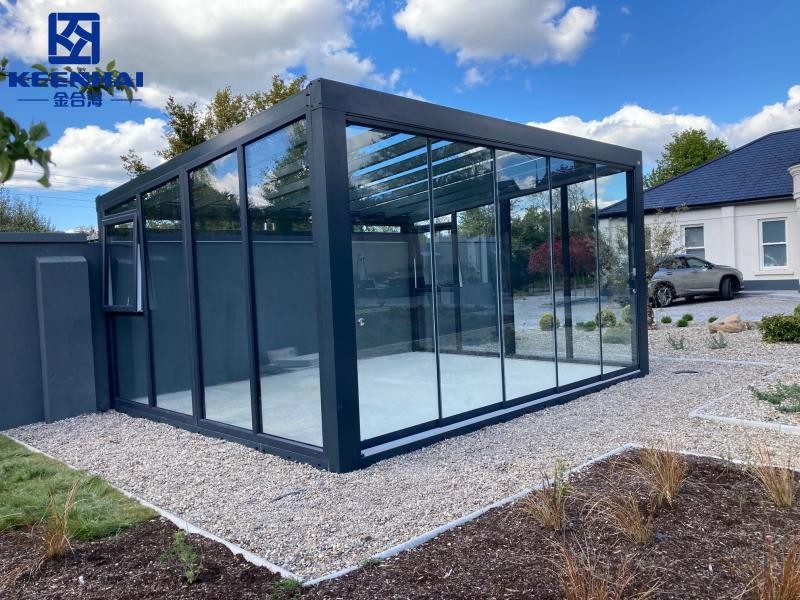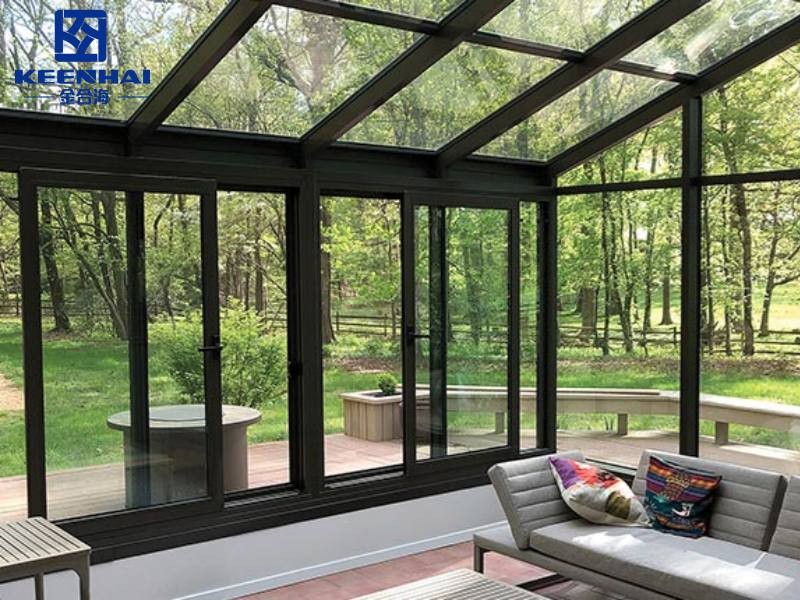
1. Average Cost of a Metal Sunroom
When planning a metal sunroom, one of the first questions that comes to mind is cost. On average, homeowners in the United States can expect to spend $15,000 to $35,000 for a fully installed aluminum or steel sunroom. The wide range comes down to factors like size, design, and materials used. For instance, a cozy 120-square-foot Aluminum Metal Solarium tucked onto a backyard deck can cost closer to the lower end, while a custom 300-square-foot Aluminum Metal Sunroom with upgraded glazing and retractable shades can easily approach the top end of the range.
1.1 National Price Range
Across different states, installation labor and material costs vary significantly. In high-cost regions like California or New York, labor alone can add $5,000–$10,000 to the total, whereas in more affordable areas like Texas or Ohio, similar projects may cost 20–30% less. The choice between aluminum vs. steel frames also plays a role: aluminum is lightweight and corrosion-resistant, making it popular for outdoor decks and patios, whereas steel provides extra strength for larger sunroom spans.
| Material Type | Average Cost per Sq Ft | Pros | Cons |
|---|---|---|---|
| Aluminum | $120–$200 | Lightweight, rust-resistant | Less strong for large spans |
| Steel | $150–$250 | Extremely durable, supports larger rooms | Heavier, may require reinforced foundation |
1.2 Typical Cost per Square Foot
On a per-square-foot basis, most standard metal sunrooms fall between $125 and $225. A typical 200-square-foot outdoor Aluminum Sunroom Outdoor can therefore range from $25,000 to $45,000 when factoring in foundation work, insulation, and professional installation. Many homeowners find that investing slightly more upfront for high-quality glazing and thermal insulation pays off over the years, reducing energy costs while improving year-round comfort. For example, a suburban family in Florida upgraded their metal sunroom with UV-protective panels, and they noticed a measurable drop in indoor heat gain during summer afternoons, making the room usable even in peak sun hours.

2. Factors That Influence the Price
When budgeting for a metal sunroom, several key factors can drastically change the final cost. Knowing these elements upfront helps homeowners make smarter decisions and avoid surprises during installation.
2.1 Size and Layout of the Sunroom
The overall size and design of your sunroom are arguably the most influential cost drivers. A compact 100–150 square-foot space will naturally cost less than a sprawling 300–400 square-foot addition. Beyond square footage, the layout—whether rectangular, L-shaped, or with angled corners—affects both material usage and labor complexity. For example:
-
Simple rectangular layouts require fewer custom cuts and support beams, reducing installation hours.
-
L-shaped or multi-wing designs demand additional framing and glazing sections, which can increase the cost by 15–25%.
-
Integrated outdoor decks or extensions may require reinforced foundations, further raising expenses.
2.2 Type of Metal Frame (Aluminum vs. Steel)
The choice of frame material has a direct impact on price, durability, and maintenance. Aluminum is lightweight, rust-resistant, and ideal for a backyard Aluminum Metal Solarium that doesn’t require heavy structural support. Steel, in contrast, offers unmatched strength for larger spans or multi-story connections but comes with higher material and labor costs. A simple comparison:
| Frame Material | Cost per Sq Ft | Weight | Maintenance | Durability |
|---|---|---|---|---|
| Aluminum | $120–$200 | Light | Low | High |
| Steel | $150–$250 | Heavy | Medium | Very High |
2.3 Roof Styles and Glazing Options
The roof style and type of glazing selected also influence pricing. Options range from single-slope or gable roofs to more complex multi-pitch designs. Glazing materials—like tempered glass, polycarbonate panels, or UV-resistant insulated glass—can significantly change the cost per square foot:
-
Tempered glass provides clarity and longevity but is heavier and slightly pricier.
-
Polycarbonate panels are lightweight and cost-effective but can scratch more easily.
-
Insulated glass improves energy efficiency, keeping the room comfortable year-round, and may reduce HVAC costs over time.
2.4 Location and Labor Costs
Geographic location directly affects labor rates and material availability. Urban areas or states with higher construction costs, such as California or New York, often charge $50–$100 per hour more for installation than less expensive regions. Additionally:
-
Local building codes may require extra permits or inspections.
-
Transportation costs for heavy steel frames can add several hundred dollars.
-
Seasonal demand impacts pricing—summer months typically have higher labor rates due to increased construction activity.
Homeowners in Florida, for example, often opt for Aluminum Sunroom Outdoor designs that withstand heat and humidity, which slightly increases material costs but enhances long-term usability.

3. Cost Breakdown by Sunroom Type
Understanding the type of sunroom you want is crucial, because the cost can vary dramatically depending on the seasonality, design, and level of customization. Here’s a breakdown of what to expect.
3.1 Three-Season Metal Sunrooms
Three-season sunrooms are built mainly for spring, summer, and fall use. They typically feature lightweight aluminum frames and single-pane glass or polycarbonate panels. These structures are ideal for homeowners who want extra living space without the expense of full insulation or HVAC integration.
-
Cost Range: $12,000–$25,000 for a 150–250 sq ft installation.
-
Materials: Aluminum frame, tempered glass or polycarbonate, basic roofing options.
-
Usage Tips: Perfect for casual lounging, reading, or as a greenhouse extension.
-
Installation Consideration: Can usually be installed in 1–2 weeks, depending on site prep.
3.2 Four-Season Metal Sunrooms
Four-season sunrooms are designed for year-round comfort. They feature stronger aluminum metal sunroom frames, insulated glazing, and sometimes integrated HVAC. These sunrooms are more like an actual room addition, supporting furniture, electronics, and even small appliances.
| Sunroom Type | Typical Cost Range | Insulation | Ideal Use Case |
|---|---|---|---|
| Three-Season | $12,000–$25,000 | Minimal | Seasonal lounging, casual entertaining |
| Four-Season | $25,000–$50,000 | High | Year-round living, home office, extended family space |
-
Cost Drivers: High-quality glazing, reinforced frames, and optional heating/cooling systems.
-
Practical Tip: Using UV-protective glass can help reduce summer heat and protect furniture from fading.
3.3 Prefab Kits vs. Custom Builds
When choosing between prefab kits and fully custom builds, consider both budget and site requirements.
-
Prefab Kits:
-
Usually come in modular sections with step-by-step instructions.
-
Cost-effective, often $100–$175 per sq ft.
-
Limited in design flexibility but faster to install.
-
Great for small backyard projects or DIY enthusiasts.
-
-
Custom Builds:
-
Fully tailored to your layout, roofing style, and material preference.
-
Can exceed $250 per sq ft depending on size and glazing options.
-
Allows integration with decks, patios, or landscaping features.
-
Ideal for homeowners seeking a seamless, high-end addition.
-
Many suburban families choose a custom Aluminum Sunroom Outdoor setup to match their home’s aesthetic while maximizing light and space. Even small design choices, like roof slope or window type, can noticeably impact both the cost and usability.

4. Additional Expenses to Consider
Even after you pick the type of sunroom you want, several extra costs can pop up that homeowners often overlook. These can make a significant difference in your final budget.
4.1 Foundation and Site Preparation
A stable foundation is essential for a long-lasting metal sunroom. Depending on your yard and soil condition, foundation work can range from a simple concrete slab to reinforced piers for uneven terrain.
-
Steps involved:
-
Surveying the site to check soil stability and slope.
-
Excavating and leveling the area.
-
Pouring concrete or installing footings.
-
Allowing proper curing time before frame installation.
-
For example, a homeowner in suburban Texas had to reinforce a slight slope, which added roughly $2,500 to their Aluminum Metal Solarium project but ensured a level, durable foundation.
4.2 Heating, Cooling, and Electrical Work
If you plan to use a four-season Aluminum Metal Sunroom, consider HVAC and electrical installation costs:
-
Electrical outlets and lighting: Adding multiple outlets, ceiling fans, or lighting can cost $1,000–$2,500, depending on wiring complexity.
-
Heating and cooling: Mini-split systems or baseboard heaters for year-round comfort typically range from $2,500–$5,000.
-
Smart home integration: Optional features like automated shades or remote-controlled ventilation panels slightly increase the budget but enhance usability.
4.3 Permits and Inspection Fees
Local regulations often require permits before adding a sunroom. Fees vary by city and project size:
| Permit Type | Average Cost | Notes |
|---|---|---|
| Building Permit | $200–$800 | Varies by size and materials |
| Electrical Permit | $50–$200 | Required if wiring is added |
| Inspection Fees | $100–$300 | Ensures compliance with codes |
Skipping permits is risky—inspections protect your investment and prevent future legal issues.
4.4 Optional Upgrades
Some upgrades, while not strictly necessary, can improve comfort, aesthetics, and long-term value:
-
UV-resistant glass panels for reducing heat and protecting furniture.
-
Retractable shades or blinds for customizable light control.
-
Custom roofing finishes to match home exterior, which can add $1,000–$3,000 depending on material choice.
-
Integrated seating or storage benches that blend into the Aluminum Sunroom Outdoor structure.
Even small design tweaks can make the sunroom feel like a seamless extension of your home rather than a standalone box.
